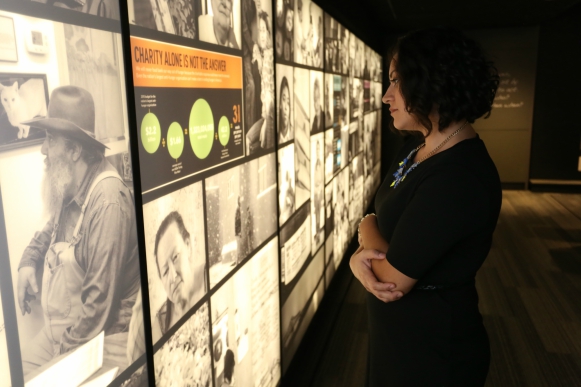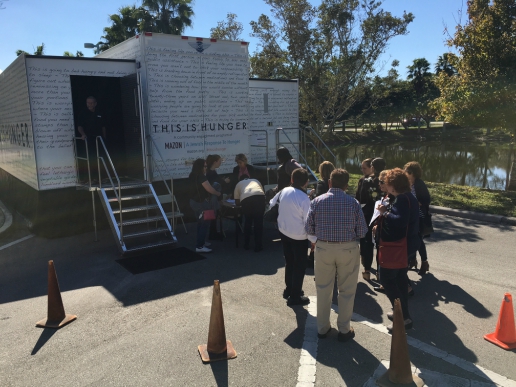Nationally touring 'This is Hunger' illuminates a quiet crisis
A unique visitor is en route to the North Coast.
Next month, a 53-foot-long double expandable trailer will pull into the Mandel Jewish Community Center of Cleveland. The big rig isn't delivering new equipment for the fitness center or supplies for the forthcoming summer camp. It houses This is Hunger, an interactive community engagement program that's touring nationwide. When parked and expanded, it provides almost 1,000 square feet of space to take participants on a voyage of awareness and activism, and to illuminate the stark reality of hunger in America. Los Angeles-based MAZON: A Jewish Response to Hunger is sponsoring the program.
 "Most people, when they think about what hunger looks like," says Michelle Stuffmann, MAZON's director of outreach and communication, "there's two images that come to people's minds. One is homeless people and the other is little children with skinny arms, distended bellies and flies all over their faces living in third world countries. Both of those are accurate, but that is not what hunger in America looks like.
"Most people, when they think about what hunger looks like," says Michelle Stuffmann, MAZON's director of outreach and communication, "there's two images that come to people's minds. One is homeless people and the other is little children with skinny arms, distended bellies and flies all over their faces living in third world countries. Both of those are accurate, but that is not what hunger in America looks like.
"Hunger in America is people who look just like you and just like me," she adds. "The reason that we're doing this is that most people are unaware that hunger is all around us."
Stuffmann says that more than one in eight people in the United States struggle to put food on the table, totaling some 42 million Americans. That struggle often has to do with food choice and economic reality. After all, when you're hungry and you only have four quarters in your hand, that dollar menu at the fast food restaurant across the street will beat out a bunch of broccoli from the market across town every time.
"The reality is that the food that is most nutrient dense is also the most expensive and/or requires time to prepare that many people who are vulnerable in our country do not have. Chips are cheap," she says.
"It's an economic choice. It's a self-preservation choice."
It's also goes beyond spinach vs. cheesy burrito, adds Stuffmann, noting that people with food insecurity often must choose between buying food and essential expenses such as rent, transportation costs and medicine.
"People with limited resources are making impossible choices every day."
But statistics and descriptions of another person's reality only go so far. Hence, MAZON launched This is Hunger.
The rig will be at the Mandel facility, 26001 Woodland Road in Beachwood, from June 2 – 5. Admission is free, however registration is required and time is of the essence — as of this writing, five of the 19 time slots were sold out.
The 45-minute experience consists of two parts. "Illuminate" invites participants to sit at a communal table to virtually meet real people struggling with hunger, who share their stories in their own words. In part two, "Advocate," participants engage in hands-on activities and experiences aimed to deepen their awareness of hunger's complexities. They're also educated on how to advocate for change.
One of the activities includes building a hypothetical meal. Participants choose from categories such as protein, vegetable and grain. Then they are given the cost of the meal they've selected. If it's more than $1.40, which is the average Supplemental Nutrition Assistance Program (SNAP) benefit per person per meal, they have to rethink their selections.
"If you were successful in getting to $1.40," poses Stuffmann, "is it a meal you'd eat? Is it a meal you'd want to eat over and over and over again?"
The simplicity and basic humanity of the exercise, she notes, helps to illuminate other points of view and "get out of your own way" when thinking about hunger and food instability.
"Because most of us need to get out of our own way," she says. "The human brain is wired to make assumptions and we're just trying to break those down a little bit."
In addition to Cleveland, the national 10-month tour includes stops in Los Angeles, Phoenix, Tucson, Dallas, Atlanta, Miami, Washington, D.C., New York, Philadelphia, Boston, St. Louis, Kansas City, Detroit, Chicago and San Francisco.
Stuffmann notes that 15 percent of rural households are food insecure and more than 13 million children and 5.7 million senor citizens struggle with hunger. There is also food insecurity in the military among both veterans and those on active duty. The sobering numbers go on and on.
This is Hunger, which is a little more than half way through its nationwide journey, leaves participants with a lasting impression about the reality of food insecurity in America.
"They don't recognize it as something that exists all around them," says Stuffmann of visitors. "Most people are shocked and horrified and incredibly moved by the experience and walk away with a feeling like I have to do more," she says. "That's what we're going for. We're trying to rally everyone to see that this issue is a massive problem and it is a crisis. It's not a tornado that hit somewhere; it's not a flood, but it is a crisis.
"It's a different kind of crisis, but a crisis nonetheless, one that we have to address," she adds, "because nobody deserves to go hungry — especially not in the wealthiest country in the world."



